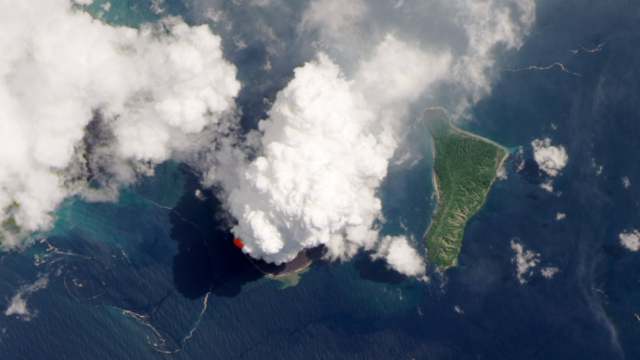Indonesia’s Anak Krakatoa volcano began erupting this past weekend. On Sunday, it spewed a stream of thick, white vapour 1,640 feet into the sky. As of Tuesday, it was still shooting out plumes. No casualties or damages have been reported so far.
Indonesia’s Centre of Volcanology and Geological Hazard Mitigation issued a Level 2 alert on a scale of four, indicating that the volcano is “exhibiting heightened or escalating unrest with increased potential of eruption, timeframe uncertain, or an eruption is underway but poses limited hazard.”
Satellites have the safest view of all when it comes to seeing eruptions. And on Monday, NASA and the U.S. Geological Survey’s Landsat 8 acquired a pretty wild image of the gas and water plume towering over Krakatoa’s peak. The satellite also saw an infrared signal peaking out from below the plume, indicating a possible lava flow.
[referenced url=” thumb=” title=” excerpt=”]
The white colour of the plume indicates that the volcano is mostly putting up water vapour and gas. If it were ash, the plume would likely look grey or brown in natural colour images. That’s not to say there couldn’t be ash hiding closer to the ground, though.
“It is possible the heavier ash particles emitted are staying lower in the atmosphere and are being transported to the north by near-surface winds,” Verity Flower, a volcanologist at NASA’s Goddard Space Flight Centre, said in a statement. “In contrast, any water and gases within the plume, which are lighter, would be transported higher and would condense rapidly in the atmosphere.”
The lack of ash reaching high into the stratosphere—which can block the sun and cool the Earth when it does—means that we’re not likely to get any reprieve from climate change from this eruption. Still, it’s been the longest eruption since 2018, when volcanic activity caused a landslide that collapsed part of the island. That eruption also spurred a tsunami that initially rose an estimated 330 feet and eventually smashed into the coast, killing 437 people.
While the current eruption is larger than usual, it’s still relatively small compared to eruptions further back in Krakatoa’s history. In 1883, a massive eruption killed an estimated 36,000 people between the blast and resulting tsunamis triggered by earthquakes.
Indonesian officials are on watch for potential coming dangers, including spurts and streams of lava and ash rain within a radius of a little more than a mile around the volcano’s crater.
